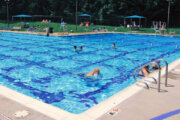Hot tubs have long been a popular home accessory, and you can find them both indoors and out. While relaxing in hot water has its benefits, these days many people are seeking the opposite experience and gravitating toward cold plunges instead.
With a cold plunge, you immerse yourself in cold water for a period of time — but often, a much shorter one than a hot tub. If you’re new to cold plunging, you might start with just 20 or 30 seconds in cold water and gradually work your way up to five to 10 minutes at a time.
There are different options for cold plunging at home, from running a cold bath to installing an oversized tub in your backyard.
[READ: Top 8 Pros and Cons of Saltwater Pools]
What Are the Benefits of Cold Plunging?
Have you ever urged a tantrum-throwing child of yours to splash some cold water on their face to calm down? Cold plunging takes that concept several steps further.
Being submerged in cold water is a good way to energize your body. It can also be a good way to recover from a strenuous workout and enhance your mood.
YouTube personality David Maus, who produces videos and content about cold plunging, says he embraced this trend as a means of alleviating stress. Cold plunging is, in a word, invigorating, according to him.
“It felt like someone hit the reset on my day,” he says of the first time he tried cold plunging.
Do You Need Special Equipment for a Cold Plunge?
You can cold plunge at any time of the day — first thing in the morning, before bed or following an afternoon run. If you’re new to it, you don’t need to buy special equipment right away.
Maus recommends starting by turning the bath or shower water cold for a few minutes and seeing how it goes. Once you’ve built up your tolerance, you can look to invest in a separate plunge tub.
“The best starting place is do cold showers for two to three months every day before investing, because the last thing you need is to spend $2,000 to $10,000 just for it to be another piece of equipment that never gets used,” Maus says.
[7 Bathroom Renovations Under $1,000]
What’s the Best Place to Put a Plunge Tub at Home?
If you decide to invest in a plunge tub, you have the choice to put it outside or indoors. The direction you go can hinge on your home’s setup, the general climate where you live and your personal preference.
Maus says that if you live in a warm climate, you might enjoy cold plunging in the sun. But you could also put a plunge tub in your garage, basement or wherever you have the space.
“Most cold plunge tubs are able to be outside, exposed to the elements,” he says.
Karen Larson, co-founder of Soake Pools, says she prefers outdoor plunging because doing it out in nature is such a great experience.
“Three minutes of cold plunging while listening to the birds or leaves rustling in the breeze is pure magic,” Larson says. “However, there is a trend towards indoor home spas that include cold plunge tubs and saunas.”
[Ways to Turn Your Home Into a Spa Retreat]
How Much Does a Plunge Tub Cost?
The cost of a plunge tub will hinge largely on the setup you want. Maus says it’s possible to spend less than $3,000, but you might also find a tub you love in the $5,000 to $9,000 range.
Larson gives an even wider range. “Cold plunge options range from rubber barrels at approximately $1,000, to hand-tiled, concrete cold plunge tubs that are approximately $27,000,” she says.
The lower-cost options are generally tubs you can place on the ground and plug in, Larson says. On the other hand, the more expensive options require installation, plumbing and, in some cases, landscaping in addition to the tub itself.
Will a Plunge Tub Cause Your Homeowners Insurance Costs to Soar?
Installing a pool is often a good way to drive your homeowners insurance costs upward. But what about a plunge tub?
Generally speaking, Larson says, you shouldn’t expect a major uptick in insurance costs from installing a plunge tub. However, “any body of water in or around a home should be protected from children or animals accidentally falling in,” she advises. That can be achieved by installing a fence barrier or a locking cover.
Larson recommends homeowners check with their insurance companies if they have questions about how a plunge tub might affect their costs.
What Does Plunge Tub Maintenance Entail?
Maus says that because plunge tubs generally move water through a filter, that mechanism does a good job of keeping them clean. It’s a good idea to drain and clean your plunge tub about once a month, he says, but you may decide to do so more or less frequently depending on how much usage your tub gets.
Plunge tub maintenance isn’t particularly difficult, Maus says.
“Most tubs hold 100 gallons of water or less, so they’re not hard to drain, and you can attach a hose and divert the water where you want it to go,” he says. Hydrogen peroxide tends to do a good job cleaning these tubs out, he adds.
All told, Maus insists, “It’s much easier to maintain this than a pool.” However, if you want to keep your tub clean, don’t get in dirty. Wiping yourself down after a workout or taking a quick rinse in the shower could prevent debris from landing in your tub, leading to less work on your part.
More from U.S. News
9 Bathroom Renovations Under $10,000
How to Design a Bathroom Wet Room
7 Bathroom Design Trends That Will Be Huge in 2024
Ready to Take the Plunge? At-Home Plunge Tub Options originally appeared on usnews.com







